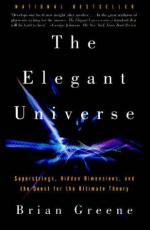
|
| Name: _________________________ | Period: ___________________ |
This quiz consists of 5 multiple choice and 5 short answer questions through Chapter 5, The Need for a New Theory, General Relativity vs. Quantum Mechanics.
Multiple Choice Questions
1. What property of electromagnetic waves did Max Planck solve the thermodynamic problem of the oven by discovering?
(a) They have a minimum energy, proportional to their frequency.
(b) There are infinite numbers of waves, but each has an infinitely small energy.
(c) They can penetrate or "tunnel" through any surface.
(d) Waves are really particles.
2. According to special relativity, which of the following is true about the passage of time for an observer moving near the speed of light?
(a) The passage of time could not be predicted.
(b) No time would pass at all.
(c) Time would pass very quickly compared to an observer at rest.
(d) Time would pass slowly compared to an observer at rest.
3. Which physicist is credited with discovering that light is composed of particles?
(a) Planck.
(b) Maxwell.
(c) Einstein.
(d) Rutherford.
4. Which of the following is not true according to special relativity?
(a) All objects move at a constant speed through space-time.
(b) Motion and time are relative; they depend on the observer.
(c) No object can move faster than the speed of light.
(d) Time does not pass for objects that are perfectly at rest.
5. According to Newton's law of gravity, the strength of the pull between two objects depends on what factors?
(a) Their densities and the strength of the gravitational field they occupy.
(b) Their masses and the distance between them.
(c) The distance between them and their average atomic numbers.
(d) Their masses and potential energies.
Short Answer Questions
1. According to general relativity, the change that an object causes in the fabric of space-time depends directly on _____.
2. Quantum physics began with the study of the energy inside a heated, closed container, such as an oven. The problem with theories at the time was that they predicted that _____.
3. Which of the following is not one of the four fundamental forces of the universe?
4. What is the fundamental particle, the smallest possible bundle of energy, for the electromagnetic force?
5. Which of the following theory was NOT developed in order to try to resolve the conflicts between quantum mechanics and general relativity?
|
This section contains 401 words (approx. 2 pages at 300 words per page) |

|




